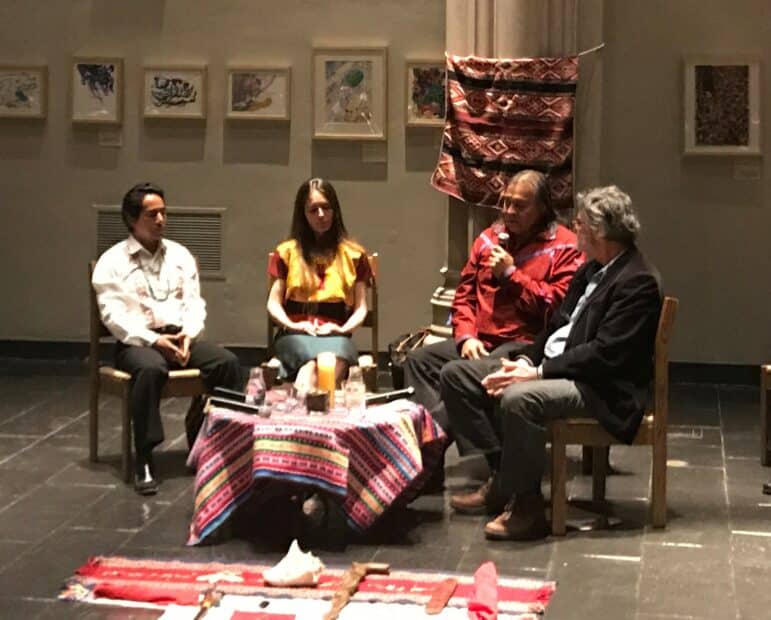
Eagle and Condor Consciousness: Three Thinkers in a Native Way
Please enjoy the Program Description and Video below.
February 21, 2018
7:00 – 8:30 pm
Union Theological Seminary
James Chapel
3041 Broadway
New York City, NY 10027
The “Original Caretakers Program” of the Center for Earth Ethics at Union Theological Seminary; The Contemplative Alliance, an Initiative of the Global initiative of Women (GPIW); and the Lake Erie Institute invite you to this groundbreaking event.
Background This program grew out of a series of GPIW sponsored dialogues with Native Americans. It will be the first in a series of programs offered throughout the country intended to bridge the gap between Western anthropocentric consciousness and indigenous holomorphic (holistic) consciousness by offering non-natives an opportunity to listen in as Natives speak to each other in their own terms about how they experience the natural world. Pilot dialogues of this kind have demonstrated their power to break through anthropocentric (human centered) categories of thinking to seeing ancient perspectives that address the critical issues facing Mother Earth and humankind.
Eagle and Condor Consciousness:
An Evening with Three Thinkers in the Native way.
The North Dakota Standing Rock prayer resistance in 2016 brought the world’s attention to an invaluable perspective, that Native Peoples have a bond not with the human race but the with living Earth. Over thousands of years, the dominant mode of human consciousness became the one we see today: technologically adept and increasingly self-absorbed—an anthropocentric or human centered consciousness that left behind a holistic mode of consciousness that was equally humanity’s endowment. The building of hierarchical and object-based “civilizations” with all of its glories and horrific conflicts came at the high cost of a steady loss of our holistic consciousness with its spiritual connection to nature.
The good news is that humanity’s holistic mode of consciousness is still active among Indigenous Peoples and may now be reemerging from its millennia-long obscurity. In the last year, for example, Indigenous groups have begun to form an alliance of Natives across the Earth in an effort to heal the devastation being wrought by anthropocentric “development.” For millennia, indigenous people throughout the world have lived in ways that maintained a balance between human life and the life of all other beings. Over time, as various cultures became more and more anthropocentrically (technologically, hierarchically, object-ively) oriented, they have disrupted that delicate balance. The environmental and ecological movements have emerged in reaction to the disastrous effects of that imbalance but have continued to apply an anthropocentric focus and anthropocentric solutions. They have largely ignored the holistic indigenous wisdom that maintained the balance between ourselves and the earth for tens of thousands of years.
This event will be a dialogue among three Indigenous thinkers whose lives are deeply rooted in traditional Native consciousness, but who are uniquely qualified to share that experience and express to the anthropocentric consciousness what a person experiences of the world as whole and interrelated. The audience will have a unique glimpse of this “holomorphic” consciousness. One of the three describes this dialogue as a process: “Wherever the spirit goes, that’s what it is,” and dialogue will happen after “we ask the Earth what she wants us to discuss.”
The holistic or holomorphic consciousness engaged through their traditional cultures is different in quite important ways from the holism found, for example in Buddhism, Hinduism, Sufism, Christian mysticism or many reported altered state experiences. The audience will discover their own parallels as they listen to Natives talk about THEIR holistic consciousness without immediately “translating” what they’re conveying into categories of what we know or think we know.
The dialogue will explore such subjects as ceremony; the “I” as “the we” way of thinking; awareness of balance and blessing; awareness of the consciousness of all beings including those beings that anthropocentric thinkers have defined as inanimate—such as water and stone—or have defined as lacking consciousness such as trees. In this time of environmental and psychological crisis for the “developed” world, Native voices and Native thinkers bring, in their presence and outlook, calm reflection and healing wisdom to an agitated and unbalanced world.
In the past few years, some non-Natives have begun to listen to what the Indigenous people have to say to us, their “younger brothers and sisters.” Their perspectives go to the heart of a potentially awakened and emerging consciousness that is both ancient and new. Three exceptionally qualified individuals representing different indigenous cultures join in sharing their experiences and traditional wisdom.
With Reflections by: Aliou Cissé Niang, New Testament faculty at Union Theological Seminary and native of Senegal West, Africa.
Tiokasin Ghosthorse (Lakota), Cheyenne River Lakota Nation of South Dakota. Tiokasin is a survivor of the U.S. Bureau of Indian Affairs Boarding and Church Missionary School systems designed to “kill the Indian and save the man,” and the “Reign of Terror” from 1972 to 1976 on the Pine Ridge, Cheyenne River, and Rosebud Lakota Reservations. He has a long history of Indigenous activism and advocacy. He is a guest lecturer at many universities and international speaker and on Peace, Indigenous and Mother Earth perspectives, cosmology, ecology and forestry and perspectives on the relational/egalitarian vs. rational/hierarchal thinking processes of western society. Tiokasin is the founder, host, and executive producer of the 25 year-old “First Voices Radio”, a weekly one-hour live program syndicated to 70 radio stations in the US and Canada. (www.firstvoicesindigenousradio.org) Tiokasin was awarded Staten Island’s Peacemaker Award in 2013 and nominated for the Nobel Peace Prize in 2016 by The International Institute of Peace Studies and Global Philosophy. He serves on boards of several charitable organizations dedicated to bringing non-western education to Native and non-Native children. He is a master flute-player and teacher of magical, ancient and modern sounds. He has performed for audiences worldwide. A Sun dancer in the Lakota Nation tradition, he describes himself as a “perfectly flawed human being.”
Mindahi Crescencio Bastida Muñoz (Otomi) is currently the Director of the Original Caretakers Program in Center for Earth Ethics at Union Theological Seminary in the City of New York and General Coordinator of the Otomi-Toltec Regional Council in Mexico, a caretaker of the philosophy and traditions of the Otomi-Toltec peoples. He has been an Otomi-Toltec Ritual Ceremony Officer since 1988. Born in Tultepec, Mexico, he holds a Doctorate of Rural Development from the Universidad Autónoma Metropolitana, Mexico. He has written extensively on the relationship between the State and Indigenous Peoples, intercultural education, collective intellectual property rights and associated traditional knowledge, among other topics. He has been coordinator of Postgraduate Academic Studies for Peace, Interculturality and Democracy, Universidad Autónoma Indígena de México (2014). He was advisor of the Provost of Universidad Autónoma Metropolitana-Unidad Lerma (2010-2013). Director of Sustainable Development Division, Universidad Intercultural del Estado de Mexico (2004-2010). He also has been or is consultant of the UNDP, UNESCO, UNEP, IISD and other international agencies. Mindahi is also deeply involved with the Biocultural Sacred Sites for Humanity, an Original Peoples Proposal, to be presented to UNESCO. He is working in the Process of Unification for the Latin American and the Caribbean Region that was initiated in Sierra Santa Marta by the Kogi and the spiritual authorities who participated there in 2013.
Geraldine Patrick Encina (Mapuche descent) is a third-year Scholar in Residence at the Center for Earth Ethics, member of the Otomi-Hñahñu Regional Council in Mexico and an in-depth researcher of the ancestral ways of conceiving and measuring cycles in Mesoamerica. She understands why the Otomi and Maya chose 2012-2013 as the time for the closing and opening of big cycles. Geraldine Ann Patrick Encina is a member of the Otomi-Hñahñu Regional Council in Mexico, and a professor of ethnoecology. Born to Chilean parents of Celtic and Mapuche origins, Geraldine received her doctorate in ethnoecology and social sciences from El Colegio Mexiquense, A. C. in 2007; she also holds a bachelor’s degree in biological sciences. She has been a visiting professor in Honduras and Argentina, and held faculty positions at several Mexican universities. Her research focuses on archaeoastronomy and cultural astronomy, particularly on ancestral and current ways of measuring and conceiving time and natural cycles in Mesoamerica, especially among Maya, Nahua and Otomian cultures. Geraldine brings extensive knowledge about the astronomical underpinnings of religious celebrations among Mesoamerican cultures. She analyzes the implications of Catholicism in current spiritual practice in Mexico and Guatemala, explaining how and why syncretism has worked for them in the past five hundred years.
Moderator for the Dialogue
John Briggs is a Connecticut State University Distinguished Professor of Aesthetics and Creative Process, author of Fire in the Crucible and Fractals, the patterns of chaos, Metaphor: The Logic of Poetry, and Seven Life Lessons of Chaos, among other books focusing on the subjects of creativity, Chaos Theory, and new scientific theories of wholeness. He holds a PhD in aesthetics and psychology from the Union Institute. John and Robert Toth of the Contemplative Alliance are currently at work on a book that explores the possibility and necessity of awakening the ancient holistic consciousness still active among many traditional peoples as a foundation for addressing the climate crisis and repairing our current cannibalistic relationship with the natural world.
